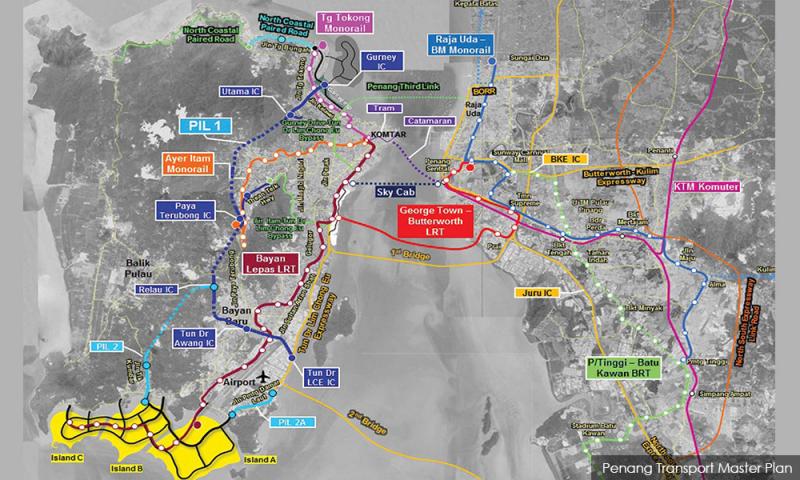Global, regional, and national outlook for Penang’s transport infrastructure
LETTER | The Asian Development Bank (ADB) estimated that the second largest sector (35 percent) with investment need is in transport infrastructure. That translates to RM148 billion (US$37 billion) a year for developing economies to enable them to “continue its economic growth momentum, eradicate poverty, and respond to climate change.”
Separately, in the Asian Infrastructure Investment Bank’s (AIIB) report, the projected investment need for “transport infrastructure to support trade and economic growth” was in the region of RM2-36 trillion (US$500-900 billion) a year. In fact, the transport sector took up the largest share of AIIB’s services.
Transport infrastructure is not cheap, but necessary all around the world.
However, among the 22 developing countries in ADB’s report, Malaysia was the third-lowest with infrastructure investment. Neighbouring countries such as the Philippines, Myanmar, Indonesia, and Vietnam had invested more in their infrastructure than Malaysia.
Vietnam is currently building not one but two metro lines (Ho Chi Minh City and Hanoi) and has the third-highest infrastructure investment among the 22. Recently, Vietnam has even surpassed Indonesia, Singapore and Malaysia as the best destination for investment.
The newly launched National Transport Policy 2019-2030 (NTP2030) aims to set the agenda for our country’s transport sector along with the technological advances enabled by the Fourth Industrial Revolution (4IR)
The development of transport infrastructure is widely recognised as a top priority for progress. It is in view of this trajectory that the NTP2030 is definitely timely and very significant for Malaysia’s development.
The global, regional development and national focus are all the more significant for a trading state like Penang that is currently implementing a transport master plan (the PTMP).
The five policy thrusts of the NTP2030 serve as a good guide for PTMP. Penang’s transport plan comprises land and sea mobility that aim to improve the transport sector (policy thrust no.1). The balanced approach of expanding road networks while building reliable public transport systems such as the Light Rail Transit (LRT) is intended to maximise the efficiency of existing and upcoming transport infrastructure (policy thrust no.2).
The PTMP’s several development phases set a long-term trajectory that covers not only the island but also the mainland in order to create seamless mobility for people and goods-transfer through multiple modes of public transport (LRT, bus rapid transit buses, trams, monorails) and a road network, this is in line with NTP2030’s policy thrust number 3.
Green technological ecosystems (NTP2030 policy thrust no.4) are constantly developing with better electric vehicles and more energy-efficient rail systems. The PTMP will be reviewed at each phase to ensure the best green infrastructure to be implemented.
With regards to expanding transport services into the global supply chain (NTP2030 policy thrust no.5), a better transport infrastructure developed through PTMP will definitely create a more convenient and reliable mobility experience to fulfil the demand of the logistics sector.
Currently, over 80 percent of total electrical and electronic (E&E) products manufactured in Penang is exported from the state’s airport into the world. Moreover, the airport will be anticipating to accommodate 20 million passengers a year from the present 7.8 million.
Furthermore, Penang being the top exporter in the country for the second quarter of this year goes to show that a good transport infrastructure connecting the airport to the E&E ecosystem and other central places should be prioritised.
Critics of the PTMP often do not have this global, regional, and national outlook to evaluate the necessity of PTMP or they do not understand Penang’s unique place as a trading state or they do not know the details of PTMP.
The article by P Gunasegaram that compares the PTMP with other projects is the latest example. For one, his cost comparison between Greater Kuala Lumpur’s rail systems with the PTMP (that comprises an LRT, rapid transit buses, trams, a monorail, an undersea tunnel, major paired roads, an elevated highway, etc) is flawed.
Penang will have to move fast to move ahead with the PTMP while the nation is gearing up our transport infrastructure through the NTP2030. Other countries like Vietnam will not wait for us. They are moving ahead aggressively to get a bigger share of the global economy.
The writers are president of the Society of Logisticians, Malaysia and a former councillor of the Seberang Perai Municipal Council, respectively.
The views expressed here are those of the author/contributor and do not necessarily represent the views of Malaysiakini.
RM12.50 / month
- Unlimited access to award-winning journalism
- Comment and share your opinions on all our articles
- Gift interesting stories to your friends
- Tax deductable
